Part – 7: Development of Male and Female Gametophytes in Cycas
<<< Part 6 —- Part 8 >>>
This is the Part 7 of the Lecture Notes Series in Cycas. Here we will continue the discussion on Sexual Reproduction in Cycas. In the previous post, we discussed the Male and Female Reproductive Structures of Cycas. Here we will see the Pollination and features of the Gametophytic Generation of Cycas. The development of Male and Female Gametophytes were discussed with diagrams. For easy understanding, a schematic diagram of the developmental pattern of Male and Female Gametophytes and the development of Archegonia is also provided.
Contents
$. Pollination
$. Development of Male Gametophyte
$. Development of Female Gametophyte
$. Development of Archegonia
Pollination in Cycas
♥. In Cycas, the pollination process is assisted by the wind.
♥. When the ovule is matured a mucilaginous watery drop ooze out from the micropyle.
You may also like: Cycas PPT (Download)
♥. This watery ooze-out is called the pollination-drop.
♥. The pollen grains coming through the wind are trapped in the pollination-drop.
♥. The pollination drop dries up and thus the pollen reaches the pollen chamber of the ovule.
♥. This type of pollination is called the pollination-drop mechanism.
♥. The pollen grains, now reached in the pollen chamber, germinate to form the male gametophyte of Cycas.
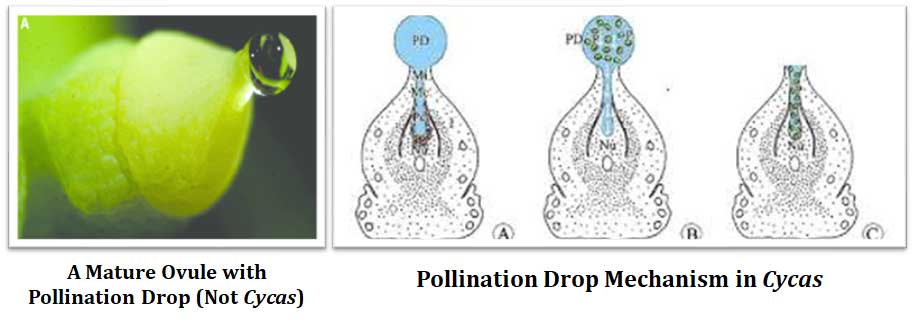
Development of Male Gametophyte in Cycas
♥. The development of male gametophyte in Cycas starts before the pollination, i.e., the division starts in the microsporangium itself.
♥. Pollen grains will be at THREE celled stage at the time of pollination.
♥. In the microsporangium, the pollen cell divides by an unequal transverse division to form two cells – a small Prothalial Cell and a large Antheridial Initial.
♥. There is no further division in the prothalial cell, it remains in the pollen as such.
♥. The antheridial initial again undergoes an unequal transverse division to form two cells – a Generative Cell and a Tube Cell.
♥. The generative cell is small and it is associated with the prothalial cell.
♥. The tube cell is large and it forms the pollen tube during the germination of pollen grain in the pollen chamber.
♥. Thus, at this stage, the pollen grain is in THREE celled stage – Prothalial cell, Tube Cell and Generative Cell.
♥. The presence of prothalial cell is considered a primitive condition and ontogenetically it represents the prothallus of Pteridophytes.
♥. Pollination occurs at this three-celled stage.
♥. After the pollination, the pollen grains germinate in the pollen chamber.
♥. During pollen germination, the tube cell elongates and the pollen exine breaks.
♥. The tube cell emerges out from the pollen grain as the pollen tube.
♥. The haustorial end of the pollen tube (tip) penetrates the nucellus and grows downward.
♥. The generative cell now undergoes a transverse division to form a Stack cell and Body cell.
♥. The stack cell is sterile and no further division occurs in this cell. Stack cell can increase its size and they store plenty of starch grains.
♥. The prominent body cell is large and it does not store starch grains.
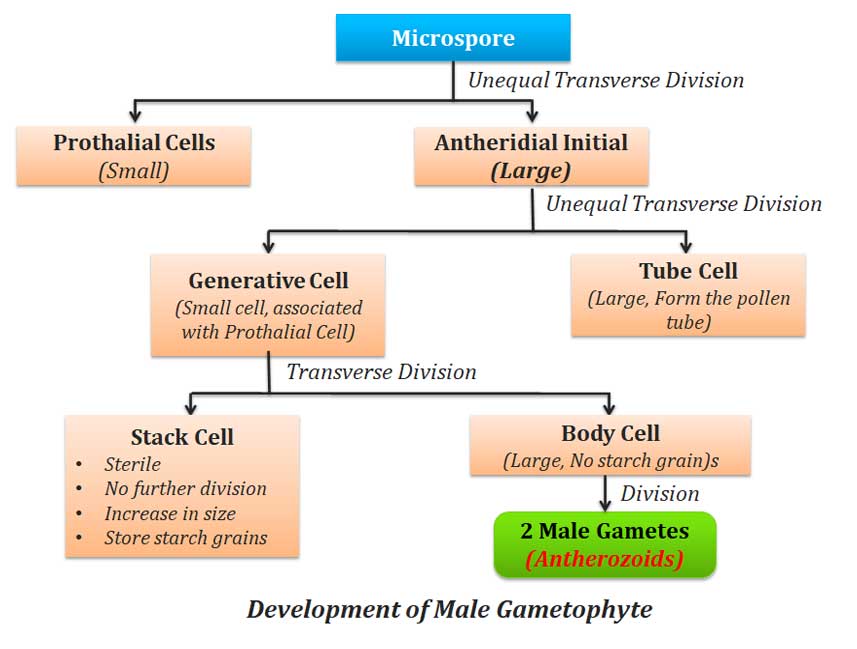
♥. The body cell enlarges. Two blepharoplasts (basal body) appears at the two poles of the nucleus of the body cell.
♥. The blepharoplast assists the formation of cilia.
♥. Ultimately the body cell divides into two antherozoids (sperms or male gametes).
♥. Sperm cells are motile and bear numerous cilia.
♥. The sperm of Cycas is the largest in the plant kingdom and it is even visible to the naked eye. They are torpedo shaped.
♥. Sperms can swim in the pollen tube with its cilia.
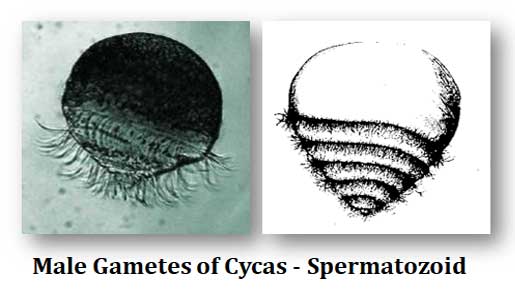
Development of Female Gametophyte in Cycas
♥. The female gametophyte is developed from the megaspore. The developed female gametophyte can be called an Embryo-sac.
♥. The functional megaspore situated deeply in the nucellus enlarges.
♥. The megaspore absorbs nutrients from the surrounding nucellar cells.
♥. Then the nucleus of the megaspore undergoes free nuclear divisions (repeated nuclear division but no cell wall formation).
♥. As a result of this free nuclear division, more than a thousand nuclei are formed within the functional megaspore.
♥. Then, a vacuole is developed in the central portion of the megaspore.
♥. The vacuoles push all the free nuclei into the periphery of the megaspore.
♥. Then, cell wall formation starts from the periphery to the center of the megaspore.
♥. Eventually, the whole embryo sac becomes cellular.
♥. This cellular structure is called the female gametophyte or Embryo-sac.
♥. The embryo-sac increase its size and more and more nucellar cells are getting absorbed by the enlarging female gametophyte.
♥. The remaining nucellar tissue form a nutritive surrounding for the developing female gametophyte.
♥. This remaining portion of the nucellus (saprophytic diploid tissue) around the gametophyte or embryo sac is called the endosperm jacket.
| You may also like NOTES in... | ||
|---|---|---|
| BOTANY | BIOCHEMISTRY | MOL. BIOLOGY |
| ZOOLOGY | MICROBIOLOGY | BIOSTATISTICS |
| ECOLOGY | IMMUNOLOGY | BIOTECHNOLOGY |
| GENETICS | EMBRYOLOGY | PHYSIOLOGY |
| EVOLUTION | BIOPHYSICS | BIOINFORMATICS |
♥. Later, archegonia are developed in the female gametophyte.
♥. All other cells of gametophyte form the endosperm having a nutritive function during the embryo development after fertilization.
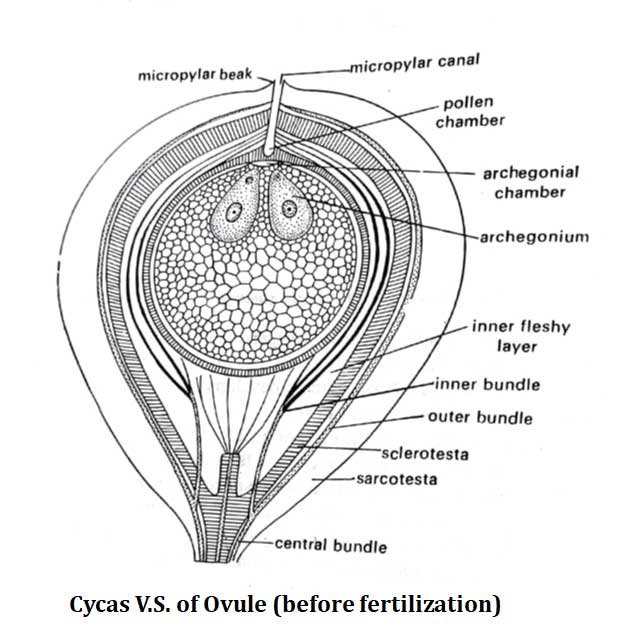
Development of Archegonia in Cycas.
♥. Archegonia is the female sex organ in Cycas.
♥. Archegonia are confined to the micropylar end of the embryo sac.
♥. The number of archegonia varies, usually, it is less than 10 per ovule.
♥. A superficial cell of the embryo sac at the micropylar end is differentiated as an Archegonial Initial.
♥. The archegonial initial divide by a transverse division to form a Primary Neck Cell and Central Cell.
♥. The primary neck cell then divides by a vertical division to form two cells which are differentiated to form the neck of the archegonium.
♥. The central cell enlarges and becomes vacuolated. It is surrounded by a distinct layer of cells of gametophytic tissue called the jacket layer.
♥. The main function of the jacket layer is the nourishment of developing archegonium.
♥. The nucleus of the central cell divides to form a venter canal nucleus and an egg nucleus.
♥. The venter canal nucleus disappears quickly whereas the egg nucleus becomes prominent in the archegonium and it acts as the egg (female gamete).
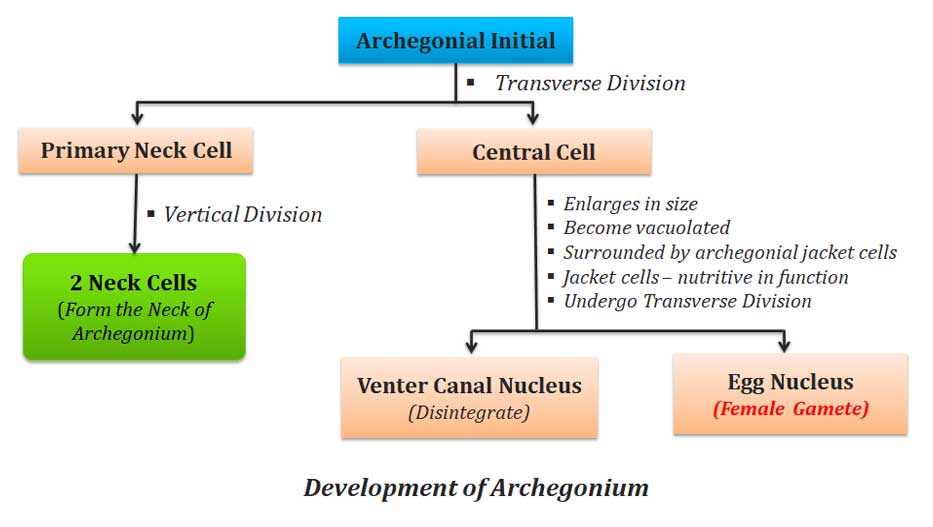
♥. In the meantime, at the micropylar end, a depression appears (the place where the archegonia are developed)
♥. The cells in this region are quickly disintegrated and absorbed and thus formed a cavity or chamber called the archegonial chamber.
♥. Archegonia open into the archegonial chamber and now they are ready to receive the male gametes to affect the fertilization.
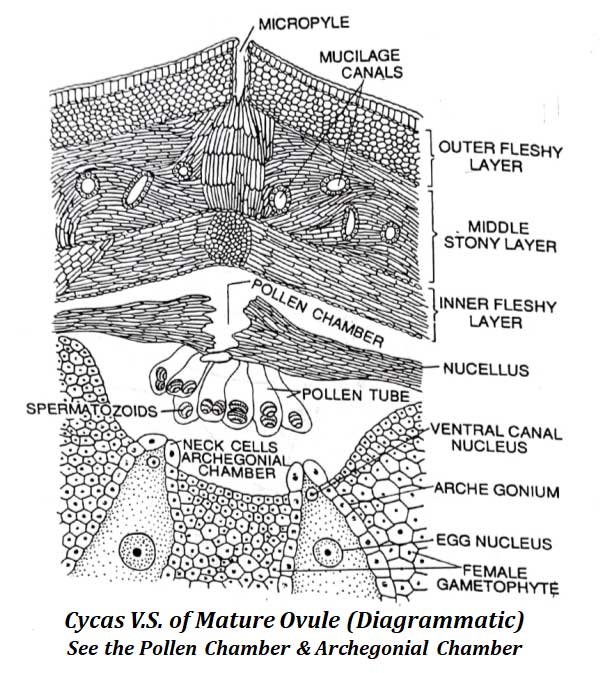
In the next post, we will see the Fertilization and Development of Embryo in Cycas.
| You may also like... | ||
|---|---|---|
| NOTES | QUESTION BANK | COMPETITIVE EXAMS. |
| PPTs | UNIVERSITY EXAMS | DIFFERENCE BETWEEN.. |
| MCQs | PLUS ONE BIOLOGY | NEWS & JOBS |
| MOCK TESTS | PLUS TWO BIOLOGY | PRACTICAL |

Great explanation!!
Very clear explanation… thank you for providing notes….